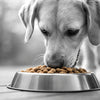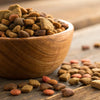Can You Put Milk on Dry Dog Food? A Comprehensive Guide for Pet Owners
- Houndsy
Table of Contents
- Introduction
- The Nutritional Value of Milk
- The Risks of Adding Milk to Your Dog's Diet
- Alternatives to Milk for Enhancing Dry Dog Food
- Practical Tips for Incorporating Liquid into Your Dog's Meals
- Elevate Your Dog's Feeding Experience with Houndsy
- Conclusion
Introduction
As devoted pet owners, we often find ourselves pondering the best ways to enhance our dogs' meals. A striking statistic reveals that 44% of pet parents feel uncertain about optimal feeding practices, which leads us to questions like, "Can you put milk on dry dog food?" This query not only highlights our desire to improve our dogs' dining experience but also underscores the importance of understanding their nutritional needs.
In this post, we will explore the complexities of adding milk to dry dog food, evaluating the benefits and risks involved, and offering alternatives that can enhance your dog's meals without compromising their health. By the end of this article, we aim to equip you with valuable insights that will help you make informed decisions about your dog's diet, ensuring they receive the nutrition they need in a safe and enjoyable manner.
We will cover the following aspects related to adding milk to dry dog food:
- The nutritional value of milk for dogs
- The risks associated with feeding milk to dogs
- Alternatives to milk that can enhance dry dog food
- Practical tips for incorporating liquids into your dog's meals
- How Houndsy can elevate your dog's feeding experience
Let’s dive into the details and reflect on our own pet feeding routines while considering what’s best for our furry friends.
The Nutritional Value of Milk
Milk is often celebrated for its rich nutritional profile. It provides essential nutrients that contribute to a dog’s overall health, including:
- Protein: Vital for muscle development and repair, protein is a crucial component of a balanced diet. It helps maintain lean body mass and supports energy levels.
- Calcium: This mineral is essential for developing strong bones and teeth, making it particularly important for growing puppies and maintaining bone health in adult dogs.
- Vitamins: Milk is a source of several vitamins, including B12 and riboflavin, which play roles in energy production and cellular function.
- Fats: Milk contains healthy fats that can provide energy and support a shiny coat.
While these nutrients sound beneficial, it’s essential to remember that not all dogs can digest milk effectively. Many adult dogs are lactose intolerant, meaning they lack the enzyme lactase necessary to break down lactose, the sugar found in milk. This can lead to gastrointestinal upset, which we must consider before introducing this dairy product to our dogs' diets.
The Risks of Adding Milk to Your Dog's Diet
Before deciding to add milk to your dog's dry food, we should be aware of potential risks associated with this practice:
1. Lactose Intolerance
As mentioned earlier, many dogs are lactose intolerant. They may experience symptoms such as:
- Diarrhea
- Gas
- Vomiting
- Stomach cramps
Monitoring your dog for these signs is crucial after introducing milk to their diet. If your dog exhibits any adverse reactions, it’s best to discontinue the practice.
2. Weight Gain and Obesity
Milk can be high in calories and fat, which may lead to weight gain if consumed in large quantities. Obesity in dogs can result in various health issues, including joint problems and diabetes. If you choose to offer milk, ensure it's in moderation and fits within your dog’s overall dietary plan.
3. Allergies and Sensitivities
Some dogs may have allergies to proteins found in milk, which can trigger an immune response leading to symptoms such as itching, rashes, or gastrointestinal upset. If you suspect your dog has a dairy allergy, consult your veterinarian for guidance.
Summary of Risks
In summary, while milk can provide certain nutritional benefits, the risks associated with lactose intolerance, weight gain, and allergies might outweigh these advantages for many dogs. It’s essential always to observe how your dog responds to any dietary changes.
Alternatives to Milk for Enhancing Dry Dog Food
If you're looking to enhance your dog's dry food without the potential risks associated with milk, several alternatives can add flavor and moisture:
1. Plain, Unsweetened Yogurt
Yogurt can be a healthier alternative to milk. The fermentation process reduces lactose content, making it easier for many dogs to digest. Additionally, yogurt contains probiotics that can promote gut health. Just be sure to choose plain, unsweetened varieties without added sugars or artificial ingredients.
2. Bone Broth
Bone broth is a nutritious option that can add flavor and moisture to your dog’s meals. It’s made by simmering animal bones in water for several hours, releasing vitamins, minerals, and amino acids beneficial for your dog’s health. Ensure the broth is low in sodium and free from harmful ingredients like onions or garlic.
3. Vegetable or Meat Broth
Low-sodium vegetable or meat broth can also enhance your dog’s dry food, making it more appetizing. Just like bone broth, it adds moisture and flavor without the risks associated with milk.
4. Warm Water
Sometimes, the simplest solution is the most effective. Adding warm water to your dog’s dry food can enhance its aroma and texture, encouraging them to eat. Allow the kibble to soak for a few minutes before serving to soften it, especially for senior dogs or those with dental issues.
Summary of Alternatives
These alternatives not only provide hydration and flavor but are also generally safer options for dogs with lactose intolerance. Incorporating these liquids can elevate your dog’s feeding experience without compromising their health.
Practical Tips for Incorporating Liquid into Your Dog's Meals
Adding liquid to your dog's dry food can be a simple way to enhance their meals. Here are some practical tips to do so effectively:
1. Mix Well
Ensure that the liquid is evenly distributed throughout the kibble to help your dog enjoy every bite without leaving any dry pieces behind. This will also prevent them from picking out only the kibble and avoiding the added liquid.
2. Soak Before Serving
Allow the kibble to soak in the liquid for about 10-15 minutes before serving. This will enhance the flavor and make it easier for your dog to chew, especially for senior dogs or those with dental issues.
3. Monitor Their Response
Keep an eye on your dog after introducing liquids to their meals. If you notice any signs of gastrointestinal distress, consult your veterinarian. It’s essential to adjust their diet gradually to allow their digestive system to adapt.
4. Consider Portion Sizes
Depending on your dog's size and dietary needs, you might want to adjust the amount of liquid you add. A good rule of thumb is to start with 1/4 cup to 1/2 cup of liquid added to their dry food, depending on their portion size.
Elevate Your Dog's Feeding Experience with Houndsy
At Houndsy, we understand that feeding your dog should be a delightful experience for both you and your furry friend. Our flagship product, the Houndsy Kibble Dispenser, is designed to simplify the feeding process while ensuring perfect portion control.
Here are some features that make our Kibble Dispenser a game-changer for pet owners:
- Convenient Crank at Standing Height: Say goodbye to bending down to serve your dog's food. Our dispenser allows for easy access at a comfortable height.
- Perfect Portion Control: Ensure your dog receives the right amount of kibble every time, helping to manage their weight and nutrition.
- Stylish Mid-Century Modern Design: Our dispenser not only works flawlessly but also complements your home decor, making feeding time a stylish affair.
- BPA-Free Liner: Keeps food fresh and safe for your furry friend.
- Auto-Locking Mechanism: Prevents accidental dispensing by curious pets or toddlers.
We invite you to explore the Houndsy Kibble Dispenser and discover how it can enhance your dog’s feeding experience while ensuring they receive the nutrition they need.
Conclusion
In conclusion, while adding milk to your dog's dry food may seem like a tempting way to enhance their meals, we must carefully consider the potential risks involved. Many dogs are lactose intolerant, which can lead to digestive issues and other health problems. Instead, consider incorporating alternatives such as yogurt, bone broth, or vegetable broth to add flavor and moisture to your dog's food.
By prioritizing your dog's health and well-being, you can create a feeding routine that is both enjoyable and nutritious. We encourage you to explore the Houndsy Kibble Dispenser to elevate your dog's feeding experience and simplify your pet care routine.
FAQ
1. Is it safe to give my dog milk?
While some dogs may tolerate small amounts of milk, many are lactose intolerant. Monitor your dog's response and consult your veterinarian if you notice any adverse effects.
2. What are some safe alternatives to milk for dogs?
Consider using bone broth, plain yogurt, or low-sodium vegetable broth to enhance your dog's dry food.
3. Can I add liquid to my dog's kibble?
Yes! Adding warm water or broth can make kibble more appealing and easier to chew.
4. How can I ensure my dog is getting the right nutrition?
Consult your veterinarian to determine the best diet for your dog's specific needs, and consider incorporating high-quality dog food along with fresh whole foods.
5. How can the Houndsy Kibble Dispenser help with my dog's feeding routine?
The Houndsy Kibble Dispenser offers a convenient, stylish, and efficient way to serve your dog kibble while ensuring perfect portion control and maintaining freshness.












